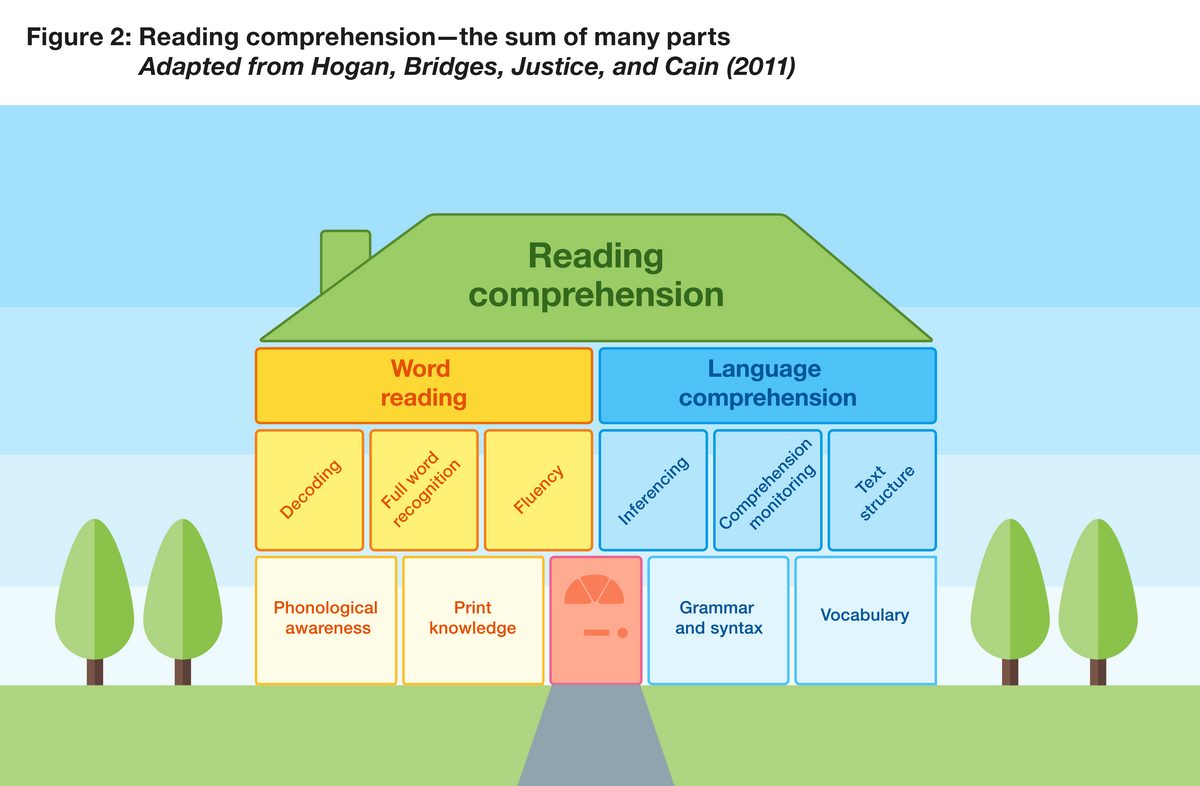A key addition to our recently updated Improving Literacy at Key Stage 2 guidance report is the the Reading House model, which communicates the multifaceted nature of reading comprehension development.
As we tour the house, it becomes clear that we need to attend to every room. We can see then that we need to connect ‘phonological awareness’ and ‘print knowledge’ up to ‘decoding’ so that every component of reading becomes well connected by high quality teaching. For instance, Storytime – which is so vital to developing pupils’ print knowledge’ continues to run alongside a structured synthetic phonics programme.
In a previous blog, we explored the ‘phonological awareness’ and ‘print knowledge’ rooms in greater detail. Now, we shift our focus upstairs to decipher the crucial role of decoding words.

What is decoding?
Decoding can be described as the process through which letters on the page are brought to life, becoming sounds and words. It is the translation of written words into the sounds of spoken language, for instance, phone- ph-o-n‑e.
Why do we need to explicitly teach decoding?
Written language is an ‘unnatural’ code that needs translating – unlike with speech and verbal communication, translating text into words is not a skill that children acquire naturally. They benefit from explicit teaching to be able to crack the alphabetic code.
How do children learn to decode?
Firstly, young pupils must be supported to develop an awareness of phoneme (sound), and grapheme (a letter, or combination of letters that represent a phoneme) correspondence.
Systematic phonics approaches explicitly teach pupils a comprehensive set of letter-sound correspondence through an organised sequence. Synthetic phonics approaches involve teaching how to decode new words by sounding them out and combining or ‘blending’ the sound spelling patterns.
The sequence is generally organised to initially introduce children to the most common graphemes, and to familiarise them with the most useful frequent pairing of graphemes in words. For example, it is common for children to be taught the phoneme/grapheme correspondences for ‘satpin’ before moving on to other letters.
It is necessary to teach these phoneme/grapheme relationships explicitly. Alongside this, children should also have the opportunity to apply and practise outside of phonics sessions during other reading and writing activities.1
Implementing a phonics programme
Robust evidence suggests that a high quality, structured phonics provision can make a positive impact on pupils’ early literacy, if implemented carefully. The EEF’s Improving Literacy in Key Stage 1 guidance report indicates that effective phonics programmes can include certain key features:
- Training—ensure all staff have the necessary pedagogical skills and content knowledge, for example, sufficient linguistic knowledge and understanding.
- Responsiveness—check if learning can be accelerated or extra support is needed and identify specific capabilities and difficulties to focus teaching.
- Engagement—lessons engage pupils and are enjoyable to teach.
- Adaptations—carefully consider any adaptations to the programme as they may reduce its impact
- Focus—a responsive approach to grouping pupils is likely to help focus pupil’s effort and improve teaching efficiency.
The Reading Comprehension House perfectly illustrates the complexity of reading, and teaching reading. More than this, it can help practitioners to focus on the key building blocks of supporting reading development – of which decoding is definitely one.
Spending teaching time that devotes energy to every room in the house, is therefore worthy of our careful consideration.
References:
1. Early Language Development: Needs, provision, and intervention for preschool children from socio-economically disadvantaged backgrounds. A Report for the Education Endowment Foundation
2. October 2017National Reading Panel (U.S.) (2000) ‘Teaching Children to Read: An Evidence-Based Assessment of the Scientific Research Literature on Reading and Its Implications for Reading Instruction’, Washington DC: National Institute of Child Health and Human Development, National Institutes of Health, 2 – 96; Ehri, L., Nunes, S., Stahl, S. and Willows, D. (2001) Systematic Phonics Instruction Helps Students Learn to Read: Evidence from the National Reading Panel’s MetaAnalysis’, Review of Educational Research, 71 (3), pp. 393 – 447.
